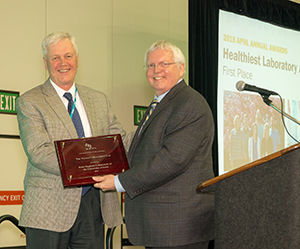
| June 2015 | |||||||||||
| Top stories | |||||||||||
| In the news | |||||||||||
| Photos | |||||||||||
| Contact us | |||||||||||
| Archive | |||||||||||
|
Association rates Iowa as healthiest public health lab |
The Association of Public Health Laboratories (APHL) says the Hygienic Laboratory is the healthiest public health lab in the nation. The top ranking in APHL’s Healthiest Laboratory award was announced at the association's annual meeting in May.

Director Christopher Atchison (left) receives the Healthiest Laboratory award from Warren Hendrickson of HDR, sponsor of the award.
Created in 2009, the APHL Healthiest Laboratory Award is part of its Healthiest Laboratory Initiative. In 2012, APHL rated the Hygienic Lab as runner-up for the award, seconded by Virginia’s Fairfax County Health Department Laboratory.
A key factor in earning the top spot this year was the lab’s high scores on the APHL Self-Assessment Checklist, which measures health promotion, environmental sustainability and policy implementation. APHL also recognized the Hygienic Laboratory Wellness Program.
Formalized in Aug. 2014, this team organized several events intended to create staff interest in ways to improve health, said Rick Bonar, STEM coordinator and Hygienic Lab’s Wellness Committee chair.
“The goal moving forward is to provide a wide variety of events and activities for the lab staff that promote their health and wellbeing,” Bonar said. “The wellness workgroup hopes to provide a dynamic range of activities that change with the needs of our laboratory staff,” said Bonar. Staff gathered for a Super Food presentation, chair massage sessions and essential oil demonstration.
Outreach Fellow Katherine Holger played a significant role in organizing a number of wellness activities, including a Pedometer Challenge and Yoga @ Work. Holger completed her practicum for the University of Iowa’s College of Public Health at the Hygienic Lab.
“Because I was only [working at the lab] for a short while, we focused on having members take ownership of their ideas, and I tried to help with follow through,” Holger said. “These programs have had great success, and seem to be making a difference in the culture of the lab.”